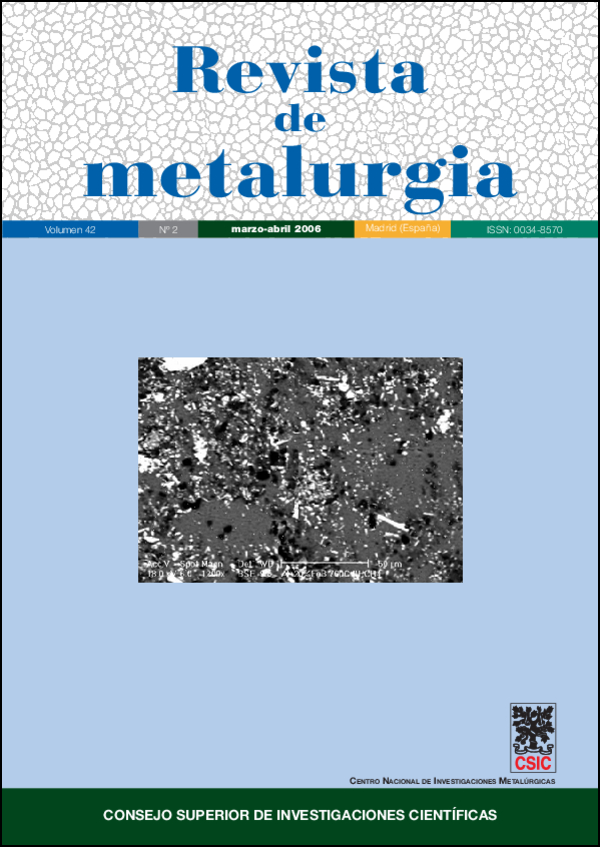Two new methods to determine the adhesion by means of internal friction in materials covered with films
DOI:
https://doi.org/10.3989/revmetalm.2006.v42.i2.14Keywords:
Adhesion, Internal friction, Thin films, Torsion pendulumAbstract
Two new models are proposed to determine the adhesion energy by means of the internal friction technique (IF) in thin films layered materials. For the first method is necessary to determine enthalpy by means of the IF technique, for which the adhesion work has been determined with experimental data. In the second method are necessary to perform IF tests at constant temperature.
Downloads
References
[1] M. Ohring, The Materials Science of Thin Films, Academic Press, Second Edition, 2002.
[2] Y. Fu, H. Du Y S. Zhang, Thin Solid Films 444 (2003) 85-90. doi:10.1016/S0040-6090(03)01029-0
[3] P. A. Steinman Y H. E. Hintermann, J. Vac. Sci. Technol. A7 (1989) 2.267-2.272.
[4] M. Ignat, M. Ducarroir, M. Lelogeais Y J. Garden, Thin Solid Films 220 (1992) 271-276. doi:10.1016/0040-6090(92)90584-X
[5] E. Harry, A. Rouzaud, M. Ignat Y P. Juliet, Thin Solid Films 332 (1998) 195-201. doi:10.1016/S0040-6090(98)01056-6
[6] D. R. Clarke, Final Report 1997-98 for Micro Project 97-032. ucop.edu/research/micro/97_98/97_032.pdf, (consultada en Marzo de 2004).
[7] M. Ignat, T. Marieb, H. Fujimoto Y P.A. Flinn. Thin Solid Films 353 (1999) 201-207. doi:10.1016/S0040-6090(99)00397-1
[8] F. Spaepen, Thin Film Mechanical Behaviour Conference, Plymouth, EE. UU., 2000.
[9] R. H. Dauskardt, Mechanical Properties of Thin Films Conference, Stuttgart, Germany, 2000.
[10] Nowick Y B. S. Berry, Anelastic Relaxation in Crystalline Solids, Academic Press, N.Y., EE. UU., 1972, pp. 372-492.
[11] Y. Nishino Y S. Asano, Phys. Stat. Sol. A 139 (1993) K97-K100. doi:10.1002/pssa.2211390232
[12] Q. Su, S. Z. Hua Y M. Wutting, J. Adh. Sci. Tech. 8 (1994) 625-633. doi:10.1163/156856194X00384
[13] J. M. San Juan, I. Gallego Y M. L. NÓ, Rev. Metal. Madrid 37 (2001) 209-214.
[14] J. M. Albuquerque, P. A. Ramos, M. A. Gomes Y A. C. Cruz, Rev. Metal. Madrid 41 (2005) 126- 132.
[15] Z. S. Li, Q. F. Fang, S. Veprek Y S. Z. LI, Mat. Sci. Eng. A 370 (2004) 186-190. doi:10.1016/j.msea.2003.09.048
[16] Z.S.Li Y Q.F.Fang, Rev. Sci. Instrum., 74 (2003) 2.477-2.480.
[17] D. Samatowicz. J. Alloys Compounds 310 (2000) 457-461. doi:10.1016/S0925-8388(00)01014-8
[18] Richard, Gremaud, Kulik Y Behrend. J. Alloys Compounds, 211/212 (1994) 438-441. doi:10.1016/0925-8388(94)90539-8
[19] H. A. Colorado, Tesis de Maestría, Universidad Nacional de Colombia, 2005.
[20] T. S. Kê, Metall. Mater. Trans. A 30 (1999) 2.267-2.295.
[21] J. Von Der Hagen, PhD thesis, Max-Planck- Institut Für Metallforschung (MPI-MF), 2003.
[22] J. M. Howe, Interfaces in Materials, University of Virginia, John Wiley and Sons, EE.UU., 1997, pp. 176-193.
[23] Burke, Reed Y Weiss, Surface and Interfaces. Syracuse University Press, 1996, pp. 361-480.
[24] H. Lüth, Surfaces and Interfaces of Solid Materials. Springer 3ª Edition, Germany, 1995, pp. 72-210.
[25] M. Hillert. Phase Equilibria, Phase Diagrams and Phase Transformations. Cambridge University Press, U.K, 1998, pp. 4-56.
Downloads
Published
How to Cite
Issue
Section
License
Copyright (c) 2006 Consejo Superior de Investigaciones Científicas (CSIC)

This work is licensed under a Creative Commons Attribution 4.0 International License.
© CSIC. Manuscripts published in both the printed and online versions of this Journal are the property of Consejo Superior de Investigaciones Científicas, and quoting this source is a requirement for any partial or full reproduction.
All contents of this electronic edition, except where otherwise noted, are distributed under a “Creative Commons Attribution 4.0 International” (CC BY 4.0) License. You may read the basic information and the legal text of the license. The indication of the CC BY 4.0 License must be expressly stated in this way when necessary.
Self-archiving in repositories, personal webpages or similar, of any version other than the published by the Editor, is not allowed.
















